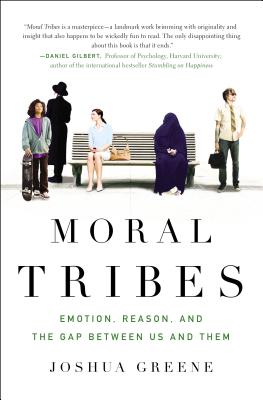A pathbreaking neuroscientist reveals how our social instincts turn Me into Us, but turn Us against Them—and what we can do about it
Our brains were designed for tribal life, for getting along with a select group of others (Us) and for fighting off everyone else (Them). But modern times have forced the world’s tribes into a shared space, resulting in epic clashes of values along with unprecedented opportunities. As the world shrinks, the moral lines that divide us become more salient and more puzzling. We fight over everything from tax codes to gay marriage to global warming, and we wonder where, if at all, we can find our common ground.
A grand synthesis of neuroscience, psychology, and philosophy, Moral Tribes reveals the underlying causes of modern conflict and lights the way forward. Greene compares the human brain to a dual-mode camera, with point-and-shoot automatic settings (“portrait,” “landscape”) as well as a manual mode. Our point-and-shoot settings are our emotions—efficient, automated programs honed by evolution, culture, and personal experience. The brain’s manual mode is its capacity for deliberate reasoning, which makes our thinking flexible. Point-and-shoot emotions make us social animals, turning Me into Us. But they also make us tribal animals, turning Us against Them. Our tribal emotions make us fight—sometimes with bombs, sometimes with words—often with life-and-death stakes.
An award-winning teacher and scientist, Greene directs Harvard University’s Moral Cognition Lab, which uses cutting-edge neuroscience and cognitive techniques to understand how people really make moral decisions. Combining insights from the lab with lessons from decades of social science and centuries of philosophy, the great question of Moral Tribes is this: How can we get along with Them when what they want feels so wrong to Us?
Ultimately, Greene offers a set of maxims for navigating the modern moral terrain, a practical road map for solving problems and living better lives. Moral Tribes shows us when to trust our instincts, when to reason, and how the right kind of reasoning can move us forward.
A major achievement from a rising star in a new scientific field, Moral Tribes will refashion your deepest beliefs about how moral thinking works and how it can work better.
Our brains were designed for tribal life, for getting along with a select group of others (Us) and for fighting off everyone else (Them). But modern times have forced the world’s tribes into a shared space, resulting in epic clashes of values along with unprecedented opportunities. As the world shrinks, the moral lines that divide us become more salient and more puzzling. We fight over everything from tax codes to gay marriage to global warming, and we wonder where, if at all, we can find our common ground.
A grand synthesis of neuroscience, psychology, and philosophy, Moral Tribes reveals the underlying causes of modern conflict and lights the way forward. Greene compares the human brain to a dual-mode camera, with point-and-shoot automatic settings (“portrait,” “landscape”) as well as a manual mode. Our point-and-shoot settings are our emotions—efficient, automated programs honed by evolution, culture, and personal experience. The brain’s manual mode is its capacity for deliberate reasoning, which makes our thinking flexible. Point-and-shoot emotions make us social animals, turning Me into Us. But they also make us tribal animals, turning Us against Them. Our tribal emotions make us fight—sometimes with bombs, sometimes with words—often with life-and-death stakes.
An award-winning teacher and scientist, Greene directs Harvard University’s Moral Cognition Lab, which uses cutting-edge neuroscience and cognitive techniques to understand how people really make moral decisions. Combining insights from the lab with lessons from decades of social science and centuries of philosophy, the great question of Moral Tribes is this: How can we get along with Them when what they want feels so wrong to Us?
Ultimately, Greene offers a set of maxims for navigating the modern moral terrain, a practical road map for solving problems and living better lives. Moral Tribes shows us when to trust our instincts, when to reason, and how the right kind of reasoning can move us forward.
A major achievement from a rising star in a new scientific field, Moral Tribes will refashion your deepest beliefs about how moral thinking works and how it can work better.
With 50 Foods, noted authority Edward Behr has created the definitive guide to the foods every food lover must know. A culinary Baedeker, 50 Foods will delight and inform the connoisseur as well as the novice.
Like Behr’s celebrated magazine, The Art of Eating, 50 Foods presents simple, practical information about buying, using, preparing, and enjoying. Behr focuses on aroma, appearance, flavor, and texture to determine what “the best” means for each food. He tells you how to select top quality—signs of freshness and ripeness, best season, top varieties, proper aging. If the way to prepare, serve, or eat something is little known, then he explains it (how to open an oyster, why the best way to cook green beans is boiling, how to clean a whole salted anchovy, when to eat and when to discard the rind of a cheese). Behr also names the most complementary foods and flavors for each of these fifty marvelous foods and the wines that go with them.
The fifty selections provide a broad sensory range for the modern gourmet. Most of the foods are raw materials, but some have been fermented or otherwise transformed—into bread, ham, cheese. Six of the fifty are cheeses. As Behr explains, cheese is probably the best food, as wine is the best drink. Behr argues that food tastes more delicious when it is closer to nature. Skilled low technology is almost always superior to high technology. But with scientific insight, the old methods can be refined to achieve more consistent high quality.
We can’t always have the best, but with the information in this book we can eat better every day. Knowing good food is part of a complete understanding of the world—part of a full enjoyment of nature, a full experience of the senses, a full life.
For the connoisseur at any level, 50 Foods is a beautifully written guide to deliciousness, with color illustrations by Mikel Jaso throughout.
Like Behr’s celebrated magazine, The Art of Eating, 50 Foods presents simple, practical information about buying, using, preparing, and enjoying. Behr focuses on aroma, appearance, flavor, and texture to determine what “the best” means for each food. He tells you how to select top quality—signs of freshness and ripeness, best season, top varieties, proper aging. If the way to prepare, serve, or eat something is little known, then he explains it (how to open an oyster, why the best way to cook green beans is boiling, how to clean a whole salted anchovy, when to eat and when to discard the rind of a cheese). Behr also names the most complementary foods and flavors for each of these fifty marvelous foods and the wines that go with them.
The fifty selections provide a broad sensory range for the modern gourmet. Most of the foods are raw materials, but some have been fermented or otherwise transformed—into bread, ham, cheese. Six of the fifty are cheeses. As Behr explains, cheese is probably the best food, as wine is the best drink. Behr argues that food tastes more delicious when it is closer to nature. Skilled low technology is almost always superior to high technology. But with scientific insight, the old methods can be refined to achieve more consistent high quality.
We can’t always have the best, but with the information in this book we can eat better every day. Knowing good food is part of a complete understanding of the world—part of a full enjoyment of nature, a full experience of the senses, a full life.
For the connoisseur at any level, 50 Foods is a beautifully written guide to deliciousness, with color illustrations by Mikel Jaso throughout.


No comments:
Post a Comment